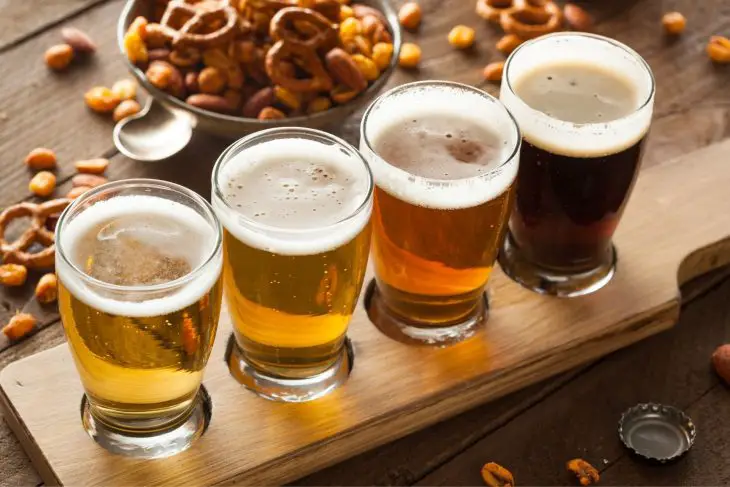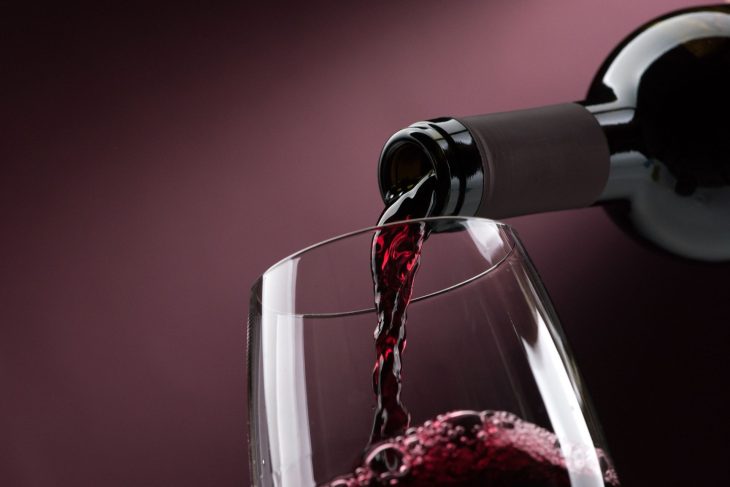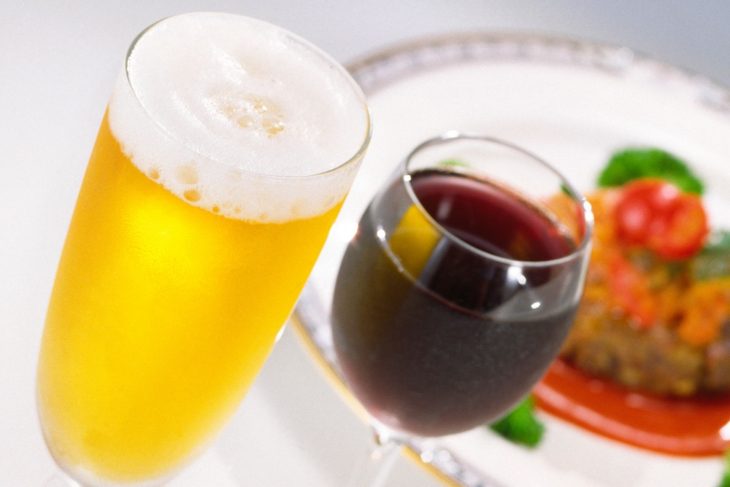Hey there! This site is reader-supported and we earn commissions if you purchase products from retailers after clicking on a link from our site.
Beer and wine are often consumed in the same setting, such as restaurants and bars or while cuddled up on the couch with a pizza. As you look over at your drinking companion, you might be wondering what they see or enjoy about their beer or wine. Maybe you want to pick up a new brew and vintage and want to know what to expect. Or you could be hoping to surprise a wine or beer drinker with your knowledge about both forms of alcohol.
Whatever your motivations are for looking up the main difference between beer and wine, we’ve got you covered.
What is Beer?
Beer is made from fermented grain; barley being the most common grain used. First, the barley is malted, or roasted enough that the grain begins to germinate. Then, the roasted grain is milled to remove the husk then boiled in water to flavor the wort. Brewers call these aforementioned steps “mashing.”
The mildly sweet wort is transferred to a kettle where it is brewed. During this time, the brewer might opt to give the wort some aroma and bitterness by incorporating hops.
Once the wort finishes brewing, the mixture is cooled, transferred to a fermenter with yeast, and then is left to sit and ferment for a few weeks. There are four main types of beer with differing flavors, mouth feel, and gravity. These include:
- Stouts and porters: These beers are thick, dark, and malty.
- Lagers: This kind of beer is aged for a couple of months and kept just above freezing during the whole process. Lagers are lighter than most beers but can be either sweet or bitter.
- Ales: Reddish or dark, these beers can be bitter to some. Ales make up a 1/3 of all the beers consumed in North America.
- Malts: Dark, sweet beers.

What is Wine?
Most wine is produced by fermenting grape juice. However, you can’t just use any type of grape. You need wine grapes. The difference between regular grapes and wine grapes is the amount of sugar. Higher amounts of sugar in wine grapes means that greater amounts of alcohol can be produced during fermentation.
Most wines are named for the region in which they are produced. Here are some of the more common types of wine:
- Chardonnay: a white wine that is dry but also contains hints of bourbon from aging in oak barrels.
- Sauvignon Blanc: a dry white that pairs well with meats and spices. It has a subtle herbaceous flavor.
- Riesling: a sweet yet tart white wine that has both floral and fruity notes.
- Pinot Grigio: a dry white that has hints of fruits.
- Pinot Noir: a dry red that is smooth yet mildly acidic.
- Zinfandel: a sweeter red wine that has a herbal edge. Some Zinfandels can be white or pink, depending on the grapes blended into the recipe.
- Cabernet Sauvignon: a thick red wine with notes of black cherry and spices.
- Syrah: a unique red wine that is said to taste like plums and tobacco.

Beer vs Wine: Serving Size and Nutrition
The typical serving size for beer is 12 ounces, while a single serving of wine is 5 ounces. A single serving of wine has the same amount of alcohol as 12 ounces of regular beer, which is also equal to 1.5 oz of an 80 proof spirit. One glass of wine will have around 11% to 13% alcohol, but there are some blends of wine that contain far less (or more). The same is true for beer, though the average 12 oz bottle runs between 4-5%. Some craft beers are much higher than that, however.
What about calories? 5 ounces of wine yields around 125 calories. The typical 12 oz bottle of beer holds around 146 calories, though some craft beers can be 300 calories per serving.
Which is Healthier—Beer or Wine?
There are widespread beliefs that drinking beer gives you a beer belly while consuming wine can be healthy for your heart. When consuming either beverage in moderation, they can both have some healthy benefits. Unfortunately, as with most alcoholic beverages, those benefits can quickly be nullified by excess consumption.
If you’re curious about which is healthier, here is what you need know:
- Excess amounts of either beer or wine can trigger headaches, hangovers, and liver damage. Red wine can even cause migraines.
- White wine has enough acid to demineralize teeth.
- Hoppy beer has nutrients that remineralize bones, increase the mineral density.
- A German study found that hops can reduce restlessness and anxiety.
- Hops can inhibit obesity.
- The nutritional value of beer is better than wine. Beer has far more B vitamins, protein, fiber, niacin, and folate than wine.
- A single glass of red wine has about 187 mg of potassium and a decent amount of fiber.
- Red wine contains resveratrol, a flavonoid that can reverse the effect of aging.
- Too much wine can elevate your triglycerides, which is associated with diabetes, kidney disease, and heart disease.
The nutritional difference between beer and wine is obvious: beer is healthier to drink in moderation and wine, and many of those benefits of wine come only from the red varieties. Sorry, white wine lovers!

Key Differences Between Beer and Wine
As you can see, the main similarity between beer and wine is that they are both derived from fermentation and contain alcohol. That’s where the common ground stops. Beer comes primarily from grains, while wine uses grapes. We also can’t overlook the differences in alcohol by volume (ABV) per serving, as well as the nutritional values of each.
Wrapping Up
In the end, beer and wine are not entirely dissimilar, though they do taste a whole lot different. Each alcohol comes with its own varieties and brewing methods. That said, the difference between beer and wine stems from your preference. Everyone has a beverage that they enjoy, so while you might love yourself a crisp glass of chardonnay, your friend might be popping open a bitter DIPA.
Frequently Asked Questions
From the health perspective, beer might be better to drink than wine. Beer has a better nutritional profile that makes it more of a food than a beverage. Compared to wine, beer has more nutrients and vitamins but less antioxidants. On the other hand, wine has fewer calories than beer and a large amount of potassium. Drink either beer or wine in excess, however, and you will find that both can make you equally drunk and unwell.
Although 1 serving size of beer (12 oz.) is considered equivalent to 5 ounces of wine, that’s not necessarily true. When you compare the ABV, a single 12oz bottle of beer with an ABV of 3.8% doesn’t compare to a 5oz glass of red wine with a 9% ABV. Drinking two glasses of a high alcohol wine is going to get you noticeably drunker more quickly than two bottles of beer.

